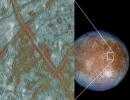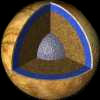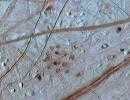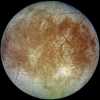Like Io, Europa has a metallic core surrounded by a layer of silicate rock. However, its surface is extremely smooth and relatively free from cratering and other collision evidence, suggesting that the surface is very young; possibly resulting from upwelling from a liquid or semi-liquid water layer beneath the crust. The layer is kept in a liquid state due the heat generated by tidal flexing of the object. The NASA website discusses two possible scenarios; see the cutaway image below. Features on the surface are mainly streaks and cracks, again probably the result of the tidal flexing creating cracks in the crust.
Europa is slightly smaller than our Moon, with an average diameter of 3,138 km. It orbits Jupiter at a distance that varies between 664,862 and 676,938 km once in just over three and a half days. It rotates on its axis synchronously, keeping the same face towards Jupiter. The eccentricity of its orbit contributes to the tidal flexing that heats the interior.
Europa's liquid water layer below the crust is widely believed to be the most likely place in the Solar System to find some form of extraterrestrial life. There are likely to be environments similar to the hydrothermal vents in Earth's oceans where life exists that does not require sun-light; just water and a source of energy.
Europa is slightly smaller than our Moon, with an average diameter of 3,138 km. It orbits Jupiter at a distance that varies between 664,862 and 676,938 km once in just over three and a half days. It rotates on its axis synchronously, keeping the same face towards Jupiter. The eccentricity of its orbit contributes to the tidal flexing that heats the interior.
Europa's liquid water layer below the crust is widely believed to be the most likely place in the Solar System to find some form of extraterrestrial life. There are likely to be environments similar to the hydrothermal vents in Earth's oceans where life exists that does not require sun-light; just water and a source of energy.
Solar System -
Jupiter's Moons
Europa
As Europa revolves synchronously with its orbit, the same hemisphere always points in the "forward" direction. This Galileo image from 1996 is of the trailing face, and is color enhanced to bring out more detail. The enlarged area of the image shows the "blocks" from which the crust is made. They appear to have broken apart and drifted; evidence that Europa may have had an ocean below its surface at some time in its past. See a larger, non-enhanced version of the main image below, right.
Click image to see two alternative theories of the internal structure of Europa.
Inner Moons • Io • Europa • Ganymede • Callisto • Himalia Group • Carme Group • Ananke Group • Pasiphae Group • Miscellaneous
Jupiter's moons are grouped as follows. Select to see details of the moon or the group of moons:
The, dark lines are fractures in the crust, some more than 3,000 km (1,850 miles) long. These can be seen clearly in the lower image. The dark spots, or "lenticulae," are about 10 km (6 miles) across, and appear to be places where ice from below erupts onto the surface. The warmer ice below rises upwards, displacing the colder surface ice that flows downwards.
Europa in approximately natural color. The crater below and right of center is Pwyll, one of very few craters on Europa. It is about 50 km (31 miles) across. The surface is mainly water ice, and the darker areas are regions with higher mineral content.





